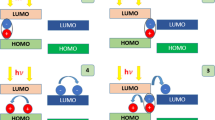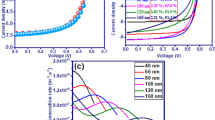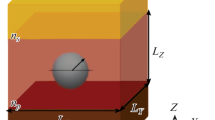Abstract
In this paper, the light absorption in the active layer of polymer solar cells (OPV) by using plasmonic nanocrystals with a hexagonal lattice structure is investigated. To study the relationship between the performance of the OPV solar cell and its active layer, a three-dimensional model of its morphology is utilized. Therefore, the three-dimensional (3D) finite-difference time-domain method and Lumerical software were used to measure the field distribution and light absorption in the active layer in terms of wavelength. OPV solar cells with bilayer and bulk heterojunction structured cells were designed using hexagonal lattice crystals with plasmonic nanoparticles, as well as core–shell geometry to govern a design to optimize light trapping in the active layer. The parameters of shape, material, periodicity, size, and the thickness of the active layer as a function of wavelength in OPV solar cells have been investigated. A very thin active layer and an ultra-thin shell were used to achieve the highest increase in optical absorption. The strong alternating electromagnetic field around the core–shell plasmonic nanoparticles resulting from the localized surface plasmon resonance (LSPR) suggested by the Ag plasmonic nanocrystals increased the intrinsic optical absorption in the active layer poly(3-hexylthiophene):phenyl-C61-butyric acid methyl ester (P3HT:PCBM). Based on the photovoltaic results, the short circuit current ranged from 19.7 to 26.7 mA/cm2.










Similar content being viewed by others
Data and Code Availability
The data that support the findings of this study are available from the corresponding author upon reasonable request.
References
Gomard Guillaume et al (2010) Two-dimensional photonic crystal for absorption enhancement in hydrogenated amorphous silicon thin film solar cells. J Appl Phys 108(12):123102. https://doi.org/10.1063/1.3506702
Dühring MB, Sigmund O (2013) Optimization of extraordinary optical absorption in plasmonic and dielectric structures. JOSA B 30(5):1154–1160. https://doi.org/10.1364/JOSAB.30.001154
Koul S (2021) Analytical modeling of the effect of silver nanoparticle incorporation in active layer of an organic solar cell. IEEE Transactions on Electron Device. https://doi.org/10.1109/TED.2021.3097970
Kaçuş Hatice et al (2021) A comparative study on the effect of monodisperse Au and Ag nanoparticles on the performance of organic photovoltaic devices. Opt Mater 116:111082. https://doi.org/10.1016/j.optmat.2021.111082
Han Seok Jun et al (2016) Symmetry-breaking nanostructures on crystalline silicon for enhanced light trapping in thin film solar cells. Opt Express 24(26):A1586-A1596. https://doi.org/10.1364/OE.24.0A1586
Bermel Peter et al (2007) Improving thin-film crystalline silicon solar cell efficiencies with photonic crystals. Opt Express 15(25):16986–17000. https://doi.org/10.1364/OE.15.016986
Furumi S (2013) Self-assembled organic and polymer photonic crystals for laser applications. Polym J 45(6):579–593. https://doi.org/10.1038/pj.2012.181
Fu Yulan, Tianrui Zhai (2020) Distributed feedback organic lasing in photonic crystals. Frontiers of Optoelectronics 13(1):18–34. https://doi.org/10.1007/s12200-019-0942-1
Yablonovitch E, Cody GD (1982) Intensity enhancement in textured optical sheets for solar cells. IEEE Trans Electron Devices 29(2):300–305. https://doi.org/10.1109/T-ED.1982.20700
Park Yeonsang et al (2009) Absorption enhancement using photonic crystals for silicon thin film solar cells. Opt Express 17(16):14312–143. https://doi.org/10.1364/OE.17.014312
Ferry Vivian E et al (2010) Light trapping in ultrathin plasmonic solar cells. Opt Express 18(102):A237-A245. https://doi.org/10.1364/OE.18.00A237
Munday JN, Atwater HA (2011) Large integrated absorption enhancement in plasmonic solar cells by combining metallic gratings and antireflection coatings. Nano Lett 11(6):2195–2201. https://doi.org/10.1021/nl101875t
Nagel JR, Scarpulla MA (2010) Enhanced absorption in optically thin solar cells by scattering from embedded dielectric nanoparticles. Opt Express 18(102):A139–A146. https://doi.org/10.1364/OE.18.00A139
Avci Ahmet H et al (2021) Photothermal sweeping gas membrane distillation and reverse electrodialysis for light-to-heat-to-power conversion. Chem Eng Process Process Intensif 164:108382. https://doi.org/10.1016/j.cep.2021.108382
Politano Antonio et al (2019) Overcoming temperature polarization in membrane distillation by thermoplasmonic effects activated by Ag nanofillers in polymeric membranes. Desalination 451:192–199. https://doi.org/10.1016/j.desal.2018.03.006
Politano Antonio et al (2017) Photothermal membrane distillation for seawater desalination. Adv Mater 29(2):1603504. https://doi.org/10.1002/adma.201603504
Zhang Wei et al (2013) Combined front diffraction and back blazed gratings to enhance broad band light harvesting in thin film solar cells. Opt Commun 298:250–253. https://doi.org/10.1016/j.optcom.2013.02.045
Krauss Thomas F, Richard M, Stuart Brand (1996) Two-dimensional photonic-bandgap structures operating at near-infrared wavelengths. Nature 383(6602):699–702. https://doi.org/10.1038/383699a0
Jalali T et al (2007) Efficient effective permittivity treatment for the 2D-FDTD simulation of photonic crystals. J Comput Theor Nanosci 4(3):644–648. https://doi.org/10.1166/jctn.2007.029
Politano A, Chiarello G (2015) The influence of electron confinement, quantum size effects, and film morphology on the dispersion and the damping of plasmonic modes in Ag and Au thin films. Prog Surf Sci 90(2):144–193. https://doi.org/10.1016/j.progsurf.2014.12.002
Rocca M, Moresco F (1996) HREELS and ELS-LEED studies of surface plasmons on Ag and Pd single crystals. Prog Surf Sci 53(2–4):331–340. https://doi.org/10.1016/S0079-6816(96)00031-7
Rocca M, Valbusa U (1993) Electronic excitations on silver single crystal surfaces. Surf Sci 287:770–775. https://doi.org/10.1016/0039-6028(93)91069-2
Maier Stefan Alexander (2007) Plasmonics: fundamentals and applications. Springer Science & Business Media. https://doi.org/10.1007/0-387-37825-1_2
Wang SY, Borca-Tasciuc DA, Kaminski DA (2011) Spectral coupling of fluorescent solar concentrators to plasmonic solar cells. J Appl Phys 109(7):074910. https://doi.org/10.1063/1.3567928
Kelly K, Lance et al (2003) The optical properties of metal nanoparticles: the influence of size, shape, and dielectric environment. 668–677. https://doi.org/10.1021/jp026731y
Ringe Emilie et al (2010) Unraveling the effects of size, composition, and substrate on the localized surface plasmon resonance frequencies of gold and silver nanocubes: a systematic single-particle approach. J Phys Chem C 114(29):12511–12516. https://doi.org/10.1021/jp104366r
Wang W, Qi L (2019) Light management with patterned micro-and nanostructure arrays for photocatalysis, photovoltaics, and optoelectronic and optical devices. Adv Func Mater 29(25):1807275. https://doi.org/10.1002/adfm.201807275
Zhu Jinfeng et al (2011) Plasmonic effects for light concentration in organic photovoltaic thin films induced by hexagonal periodic metallic nanospheres. Appl Phys Lett 98(15):151110. https://doi.org/10.1063/1.3577611
N’konou Kekeli, Leo Peres, Philippe Torchio (2018) Optical absorption modeling of plasmonic organic solar cells embedding silica-coated silver nanospheres. Plasmonics 13(1):297–303. https://doi.org/10.1007/s11468-017-0514-4
Chen, Fang-Chung et al (2009) Plasmonic-enhanced polymer photovoltaic devices incorporating solution-processable metal nanoparticles. Applied Physics Letters 95(1):182. https://doi.org/10.1063/1.3174914
Yoon Woo-Jun et al (2010) Plasmon-enhanced optical absorption and photocurrent in organic bulk heterojunction photovoltaic devices using self-assembled layer of silver nanoparticles. Solar Energy Materials and Solar Cells 94(2):128–132. https://doi.org/10.1016/j.solmat.2009.08.006
Kulkarni Abhishek P et al (2010) Plasmon-enhanced charge carrier generation in organic photovoltaic films using silver nanoprisms. Nano Letters 10(4):1501–1505. https://doi.org/10.1021/nl100615e
Stratakis E, Kymakis E (2013) Nanoparticle-based plasmonic organic photovoltaic devices. Mater Today 16(4):133–146. https://doi.org/10.1016/j.mattod.2013.04.006
Diukman Iddo et al (2011) Controlling absorption enhancement in organic photovoltaic cells by patterning Au nano disks within the active layer. Opt Express 19(101):A64-A71. https://doi.org/10.1364/OE.19.000A64
Stranks Samuel D et al (2013) Electron-hole diffusion lengths exceeding 1 micrometer in an organometal trihalide perovskite absorber. Science 342(6156):341–344. https://doi.org/10.1126/science.1243982
Kambhampati P (2011) Hot exciton relaxation dynamics in semiconductor quantum dots: radiationless transitions on the nanoscale. J Phys Chem C 115(45):22089–22109. https://doi.org/10.1021/jp2058673
Ohkita Hideo et al (2008) Charge carrier formation in polythiophene/fullerene blend films studied by transient absorption spectroscopy. J Am Chem Soc 130(10):3030–3042. https://doi.org/10.1021/ja076568q
Piralaee M, Asgari A, Siahpoush V (2018) Plasmonic properties of spheroid silicon-silver nanoshells in prolate and oblate forms. Optik 172:1064–1068. https://doi.org/10.1016/j.ijleo.2018.07.131
Krebs FC et al (2013) Freely available OPV—the fast way to progress. Energy Technology 1(7):378–381. https://doi.org/10.1002/ente.201300057
Daneshfar N (2021) The study of scattering-to-absorption ratio in plasmonic nanoparticles for photovoltaic cells and sensor applications. Plasmonics 1–7. https://doi.org/10.1007/s11468-021-01464-z
Pathak NK, Kumar PS, Sharma RP (2019) Plasmonic perovskite solar cells utilizing noble metal–metal oxide hybrid nanoparticles. Noble Metal-Metal Oxide Hybrid Nanoparticles Woodhead Publishing 487–498. https://doi.org/10.1016/B978-0-12-814134-2.00022-X
Catchpole KR, Albert P (2008) Plasmonic solar cells. Optics Express 16(26):21793- 21800. https://doi.org/10.1364/OE.16.021793
Matheu P et al (2008) Metal and dielectric nanoparticle scattering for improved optical absorption in photovoltaic devices. Appl Phys Lett 93(11):113108. https://doi.org/10.1063/1.2957980
Mohan Jain S (2006) Mutation-assisted breeding for improving ornamental plants. XXII International Eucarpia Symposium, Section Ornamentals, Breeding for Beauty 714. https://doi.org/10.17660/ActaHortic.2006.714.10
Van Dijk, Jan AGM (2006) Digital divide research, achievements and shortcomings. Poetics 34(4–5):221-235. https://doi.org/10.1016/j.poetic.2006.05.004
Rai P (2019) Plasmonic noble metal@ metal oxide core–shell nanoparticles for dye-sensitized solar cell applications. Sustainable Energy Fuels 3(1):63–91. https://doi.org/10.1039/C8SE00336J
Gu Qiongchan et al (2021) Plasmon enhanced perovskite-metallic photodetectors. Materials & Design 198:109374. https://doi.org/10.1016/j.matdes.2020.109374
Peng J, Lin Lu, Yang H (2013) Review on life cycle assessment of energy payback and greenhouse gas emission of solar photovoltaic systems. Renew Sustain Energy Rev 19:255–274. https://doi.org/10.1016/j.rser.2012.11.035
Yee K (1966) Numerical solution of initial boundary value problems involving Maxwell’s equations in isotropic media. IEEE Trans Antennas Propag 14(3):302–307. https://doi.org/10.1109/TAP.1966.1138693
Atwater Harry A, Albert P (2011) Plasmonics for improved photovoltaic devices. Materials for Sustainable Energy: A Collection of Peer-reviewed Research and Review Articles from Nature Publishing Group 1–11. https://doi.org/10.1142/9789814317665_0001
Kitai Adrian (2011) Principles of solar cells, LEDs and diodes. Departments of Engineering Physics and Materials Science and Engineering, McMaster University, Hamilton. https://doi.org/10.1002/9781119974543
Huo Y, Zhang H-L, Zhan X (2019) Nonfullerene all-small-molecule organic solar cells. ACS Energy Lett 4(6):1241–1250. https://doi.org/10.1021/acsenergylett.9b00528
Fan Baobing et al (2019) Achieving over 16% efficiency for single-junction organic solar cells. Sci China Chem 62(6):746–752. https://doi.org/10.1007/s11426-019-9457-5
An Ning et al (2020) Solution‐processed organic solar cells with high open-circuit voltage of 1.3 V and low non-radiative voltage loss of 0.16 V. Adv Mater 32(39):2002122. https://doi.org/10.1002/adma.202002122
Zhang Yu et al (2017) 2D black phosphorus for energy storage and thermoelectric applications. Small 13(28):1700661. https://doi.org/10.1002/smll.201700661
Brabec Christoph Joseph et al (2003) eds. Organic photovoltaics: concepts and realization. Vol. 60. Springer Science & Business Media
Thompson BC, Fréchet JM (2008) Polymer–fullerene composite solar cells. Angew Chem Int Ed 47(1):58–77. https://doi.org/10.1002/anie.200702506
Lightsource SS Radiation (2018) Stable solvent for solution-based electrical doping of semiconducting polymer films and its application to organic solar cells. https://doi.org/10.1039/C8EE00811F
Abass A et al (2012) Dual-interface gratings for broadband absorption enhancement in thin-film solar cells. Physical Review B 85(11):115449. https://doi.org/10.1103/PhysRevB.85.115449
Venugopal N et al (2017) Titanium nitride as light trapping plasmonic material in silicon solar cell. Opt Mater 72:397–402. https://doi.org/10.1016/j.optmat.2017.06.035
Samajdar DP (2020) Performance enhancement of nanopyramid based Si hybrid solar cells utilizing the plasmonic properties of oxide coated metal nanoparticles. Opt Mater 107:110166. https://doi.org/10.1016/j.optmat.2020.110166
N’Konou K, Philippe T (2019) optical absorption modeling of plasmonic organic solar cells embedding Ag–SiO2 core–shell nanoparticles. Noble Metal-Metal Oxide Hybrid Nanoparticles Woodhead Publishing 265–282. https://doi.org/10.1016/B978-0-12-814134-2.00013-9
Kluczyk K et al (2019) On modeling of plasmon-induced enhancement of the efficiency of solar cells modified by metallic nano-particles. Nanomaterials 9(1):3. https://doi.org/10.3390/nano9010003
Qu D et al (2011) Mechanism of optical absorption enhancement in thin film organic solar cells with plasmonic metal nanoparticles. Optics Express 19(24):24795–24803. https://doi.org/10.1364/OE.19.024795
Gunnarsson L et al (2001) Interparticle coupling effects in nanofabricated substrates for surface-enhanced Raman scattering. Appl Phys Lett 78(6):802–804. https://doi.org/10.1063/1.1344225
Lu L et al (2013) Cooperative plasmonic effect of Ag and Au nanoparticles on enhancing performance of polymer solar cells. Nano Letters 13(1):59–64. https://doi.org/10.1021/nl3034398
Xu H, Käll M (2002) Modeling the optical response of nanoparticle-based surface plasmon resonance sensors. Sens Actuators, B Chem 87(2):244–249. https://doi.org/10.1016/S0925-4005(02)00243-5
Acknowledgements
We are thankful to the Persian Gulf University Research Council for continuous support.
Author information
Authors and Affiliations
Contributions
A. Mohammadi designed and directed the project, and with L. Shabani, contributed to the design and implementation of the research; A. Mohammadi, L. Shabani, T. Jalali contributed to the analysis of the results and to the writing of the manuscript.
Corresponding author
Ethics declarations
Ethical Approval
This paper does not contain any studies with human participants or animals performed by any of the authors.
Consent to Participate
Not applicable.
Consent for Publication
Not applicable.
Conflict of Interest
The authors declare no competing interests.
Additional information
Publisher's Note
Springer Nature remains neutral with regard to jurisdictional claims in published maps and institutional affiliations.
Rights and permissions
About this article
Cite this article
Shabani, L., Mohammadi, A. & Jalali, T. Numerical Study of Plasmonic Effects of Ag Nanoparticles Embedded in the Active Layer on Performance Polymer Organic Solar Cells. Plasmonics 17, 491–504 (2022). https://doi.org/10.1007/s11468-021-01539-x
Received:
Accepted:
Published:
Issue Date:
DOI: https://doi.org/10.1007/s11468-021-01539-x




